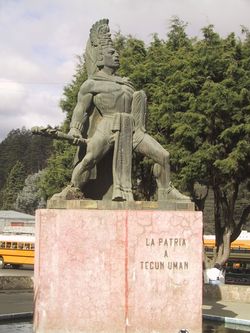CZ:Featured article/Current: Difference between revisions
imported>Johan Förberg m (moved CZ:Featured article to CZ:Featured article/Current) |
imported>Chunbum Park No edit summary |
||
| Line 1: | Line 1: | ||
{{Image| | {{Image|Tecun_Uman_statue-Quetzaltenango.jpg|right|250px}} | ||
''' | '''Tecum Umam''' was a legendary figure of [[Guatemala]]n and [[K'iche']] history. Despite a debate over his historical reality, Tecum Umam is at once a symbol of the state and a symbol of the peoples within the state. Whether in the candlelit ceremonies of ''sacerdotes Mayas'' or in the chambers of the national congress, Tecum Umam's presence is felt in nearly every niche of the daily life of the Guatemalan people. He is celebrated by poets and invoked in ritual and festival contexts throughout the highlands. He has been raised to the status of national hero of Guatemala and commemorated on its currency. And he is known as the defender of the K'iche' people and a symbol of indigenous resistance because he refused to surrender to the Spanish conquest of his homeland. | ||
'' | The legend of Tecum Umam says that he commanded the thousands of K'iche' warriors who met the army of invading Spanish and indigenous warriors under [[Pedro de Alvarado]] on the plains of El Pinar in February of 1524. In the midst of the fray, Tecum Umam and Alvarado met face to face, each with weapon in hand. Alvarado was mounted on a horse and clad in armor while Tecum Umam wore the feathers of his [[nagual]] (animal spirit counterpart), the [[Resplendent quetzal|quetzal]]. A battle ensued that claimed the life of the K'iche' hero. | ||
Taking to the sky in the form of an eagle, Tecum Umam struck down Alvarado's horse believing man and animal to be one and the same. He realized his error and turned for a second attack but Alvarado's spear pierced his opponent's chest and Tecum Umam fell to the ground dead. Then a quetzal landed on the fallen hero's chest, staining its breast feathers red with blood; the bright colors of the quetzal continue to remind us today of the great deeds of Tecum Umam. | |||
Revision as of 10:20, 21 May 2011
Tecum Umam was a legendary figure of Guatemalan and K'iche' history. Despite a debate over his historical reality, Tecum Umam is at once a symbol of the state and a symbol of the peoples within the state. Whether in the candlelit ceremonies of sacerdotes Mayas or in the chambers of the national congress, Tecum Umam's presence is felt in nearly every niche of the daily life of the Guatemalan people. He is celebrated by poets and invoked in ritual and festival contexts throughout the highlands. He has been raised to the status of national hero of Guatemala and commemorated on its currency. And he is known as the defender of the K'iche' people and a symbol of indigenous resistance because he refused to surrender to the Spanish conquest of his homeland.
The legend of Tecum Umam says that he commanded the thousands of K'iche' warriors who met the army of invading Spanish and indigenous warriors under Pedro de Alvarado on the plains of El Pinar in February of 1524. In the midst of the fray, Tecum Umam and Alvarado met face to face, each with weapon in hand. Alvarado was mounted on a horse and clad in armor while Tecum Umam wore the feathers of his nagual (animal spirit counterpart), the quetzal. A battle ensued that claimed the life of the K'iche' hero.
Taking to the sky in the form of an eagle, Tecum Umam struck down Alvarado's horse believing man and animal to be one and the same. He realized his error and turned for a second attack but Alvarado's spear pierced his opponent's chest and Tecum Umam fell to the ground dead. Then a quetzal landed on the fallen hero's chest, staining its breast feathers red with blood; the bright colors of the quetzal continue to remind us today of the great deeds of Tecum Umam.
